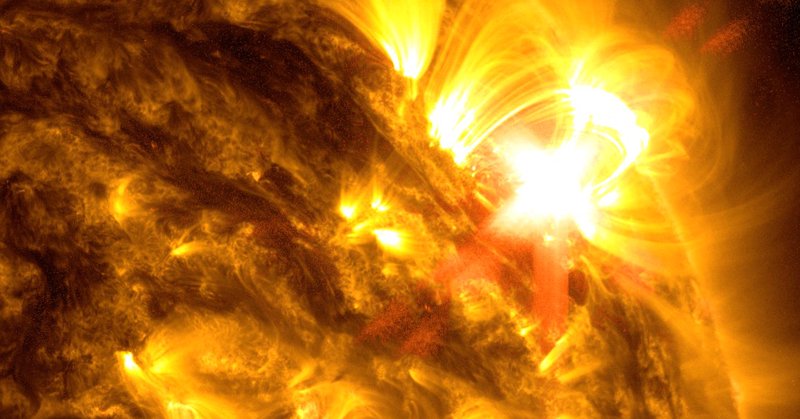
ARCHIVED - NASA Sun & Space
@NASASun
Followers
1M
Following
2K
Media
6K
Statuses
15K
This account has been archived. Follow @NASASpaceAlerts for news about solar activity and @NASASolarSystem for all other Heliophysics-related news.
Joined June 2008
Hey @NASASun fans – this account is moving! 🚛 Going forward, all solar activity reports and alerts will come from the new @NASASpaceAlerts account, where we'll share breaking news about solar activity as well as asteroids, meteors, comets, and noteworthy happenings in our local
93
35
208
The TRACERS live telecon starts in 1 hour! Listen in as mission experts discuss this soon-to-launch mission to study magnetic explosions in space. 🧲💥 https://t.co/CyzSRLU2By
24
7
51
Answer: That thing blocking the Sun at 2:47 is... us! 🌎 SDO has entered its Earth eclipse season, a three-week period that happens twice a year. During Earth eclipse season, SDO's orbit takes it behind Earth for brief period of time, momentarily blocking the spacecraft's view.
3
5
47
At about 2:47 in the above video, something briefly blocks SDO’s view of the Sun. What is it? Share your guesses below – the answer will be revealed Monday, July 14 at noon ET! 🎉 More on flares & coronal mass ejections:
science.nasa.gov
Solar storms and flares are eruptions from the Sun that can affect us here on Earth.
7
23
105
It’s #SunDay! This week’s (July 4 - 10) space weather report includes: · 2 M-class flares · 0 C-class flares · 32 coronal mass ejections · 0 geomagnetic storms This video from NASA’s Solar Dynamics Observatory (SDO) shows the week’s activity. At about 2:33, SDO performs one
22
177
568
From tracking plasma flows on the Sun, to detangling solar eruptions, to creating a “digital twin” of our entire neighborhood in space, NASA’s DRIVE Science Centers are on the case – and they now have new webpages! 👇 https://t.co/smnAkwVFfA
https://t.co/oHI1tXrhP3
17
130
523
This is the view from WITHIN the Sun’s atmosphere! ☀️👀🛰️ NASA’s Parker Solar Probe just released imagery from its closest-ever flyby of the Sun, revealing details in the solar atmosphere that scientists will be studying for years. More: https://t.co/ZDyJ1ReiWC
31
294
856
This month, the Sun is stealing the spotlight! July’s #NASAScience calendar image showcases a spectacular solar eruption, captured in Dec. 2023 by the SUVI instrument aboard NOAA’s GOES West satellite. This SUVI 304Å image reveals plasma in the Sun’s upper chromosphere, at a
13
99
348
It’s #SunDay! This week’s (June 27 - July 3) space weather report includes: · 0 M-class flares · 1 C-class flare · 25 coronal mass ejections · 0 geomagnetic storms This video from NASA’s Solar Dynamics Observatory (SDO) shows the week’s activity. More on flares & coronal mass
20
242
779
It looked like a minor solar eruption — but it had a major effect on Earth. ☀️💥🌎 In April 2023, a relatively weak solar storm produced vibrant auroras visible as far south as Arizona. Now, scientists have new insights into what made this storm so impactful — and how we
38
100
528
Two successful launches, and that’s a wrap! 🚀🚀 The two SEED mission rockets launched from Kwajalein Atoll in the Marshall Islands on June 20 and June 28, reaching peak altitudes of 95 miles (153 kilometers) and 97 miles (157 km), respectively. Preliminary data suggest that
9
43
229
It’s #SunDay! This week’s (June 20-26) space weather report includes: · 2 M-class flares · 2 C-class flares · 34 coronal mass ejections · 0 geomagnetic storms This video from NASA’s Solar Dynamics Observatory (SDO) shows the week’s activity. More on flares & coronal mass
15
185
570
Thank you to the millions who watched NASA's eclipse broadcast, took time to experience the eclipse, and shared in the wonder of the Sun and our place within this amazing universe.♥️ And HUGE congrats to the @NASASun team members who made this broadcast possible! It took many
We won an Emmy! Our live broadcast coverage of the 2024 total solar eclipse received this year's Emmy Award for Outstanding Live News Special. Get the details: https://t.co/46GQ0MoJ8Y
6
21
155
2/2 🧵 The solar wind fills space around us to create a giant "bubble" we call the heliosphere. The heliosphere’s size, shape, and dynamics are mostly still unknown — but maybe not for long! NASA’s IMAP (Interstellar Mapping and Acceleration Probe) mission, scheduled to
9
63
326
Four facts about the solar wind that will blow your mind: ☀️🌬️🤯 1. The solar wind has been blowing non-stop since the Sun formed about 4.6 billion years ago. ⌛ 2. It travels about 1 million miles an hour (and faster). 🏃 3. It carries about 1.5 million tons of mass away
48
399
1K
Another daring dive by the Sun, complete! 🛰️☀️✅ On Thursday, June 19, NASA’s Parker Solar Probe completed its 24th close approach to the Sun, matching its record distance of 3.8 million miles (about 6.2 million kilometers) from the solar surface and mind-melting top speed of
22
107
455
It’s #SunDay! This week’s space weather report includes: · 2 X-class flares · 12 M-class flares · 38 coronal mass ejections · 1 geomagnetic storm This video from NASA’s Solar Dynamics Observatory (SDO) shows the week’s activity. The two X-class flares both erupted from the same
26
168
613
IMAP is now at the Astrotech Space Operations Facility near the agency's Kennedy Space Center in Florida prepping for launch later this fall. IMAP will study the heliosphere, the Sun’s magnetic bubble protecting our solar system from interstellar space. More about IMAP:
3
9
43
So fresh and so clean, clean 🧼🫧 Inside the clean room at the Johns Hopkins Applied Physics Lab, NASA’s IMAP (Interstellar Mapping and Acceleration Probe) got its 10 instruments integrated into the spacecraft. 👇
11
51
239


